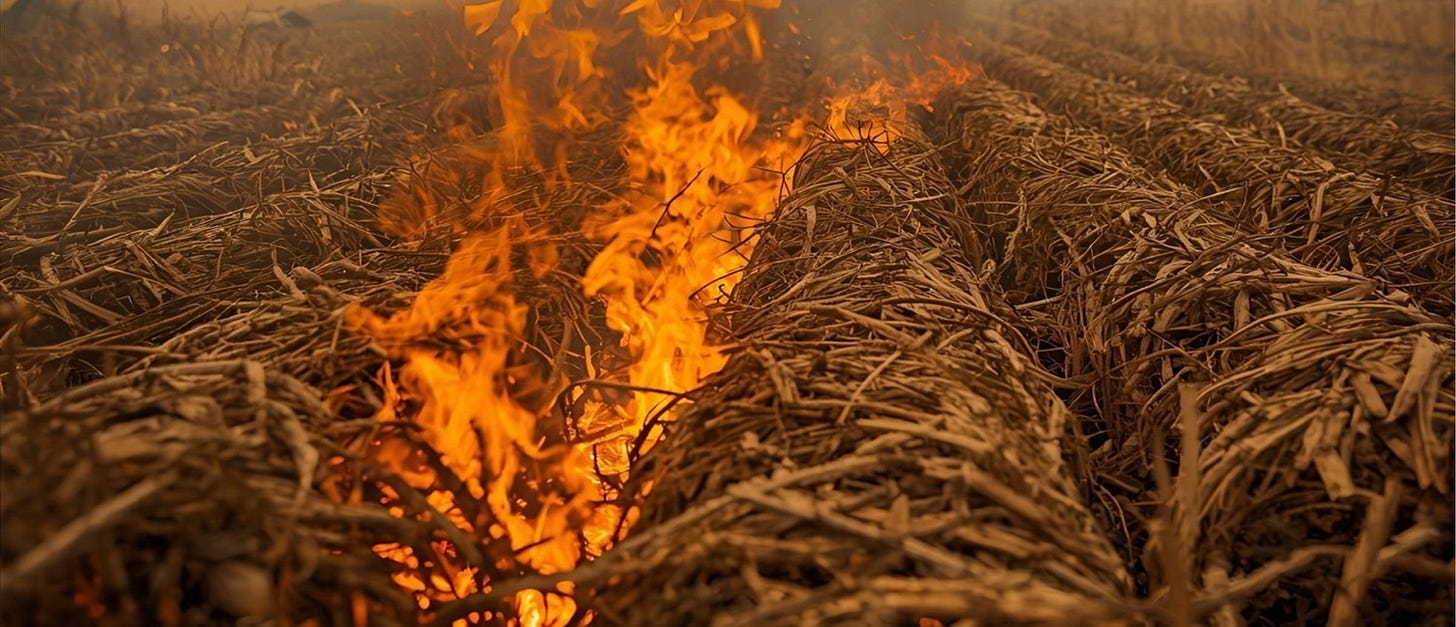The Fire Next Season: What India’s Crop-Burning Crisis Teaches About Policy and Governance
India’s farm-fire bans show that deterrence fades fast when rules outlast capacity and credible alternatives lag behind
View as PDF
Shefali Khanna: London School of Economics and Political Science (LSE)
Kanika Mahajan: Ashoka University
Sudarshan Ramanujam: Vancouver School of Economics, University of British Columbia
SDG 3: Good Health and Well-Being | SDG 12: Responsible Consumption and Production | SDG 13: Climate Action | SDG 15: Life on Land
Institutions: Ministry of Environment, Forest and Climate Change | Ministry of Agriculture and Farmers’ Welfare
Each winter, as North India vanishes beneath a choking haze, the same question hangs in the air: why, despite bans, fines and public outrage, do the fires return? Crop-residue burning – farmers setting ablaze the stubble left after the rice harvest – has become one of India’s most visible environmental challenges.
It is not simply a violation; it is an economic calculation shaped by time, cost and capacity. Understanding why it continues – and why policy responses have produced only brief gains – offers a window into how laws, incentives and institutions interact in practice.
But before examining why it persists, it is worth recalling what it costs.
The Hidden Costs of Burning
The environmental damage from burning goes well beyond the visible smoke. Each fire strips the soil of organic matter, depletes nutrients and reduces long-term fertility. It also releases large quantities of greenhouse gases – roughly 3.5 percent of global emissions. What appears to save effort in the short run ultimately undermines the land’s productivity and the farmer’s future income.
Air pollution accounted for approximately 1.67 million premature deaths in India in 2019, which is 17.8% of the total deaths in the country. Studies link crop residue burning – a major contributor to air pollution – to higher infant mortality, stunted growth and diminished cognitive performance, turning an agricultural practice into a national health emergency.
Why Farmers Burn Stubble
Indian farmers torch roughly 100 million tonnes of residue every year – about a fifth of what the country produces. Delhi, Punjab, Haryana, Uttar Pradesh and Rajasthan account for nearly 70 percent of this total. Most of it occurs in Punjab and Haryana, where farmers have less than three weeks between harvesting rice and sowing wheat. Ground-water conservation laws – Subsoil Water Acts of 2009, which delayed rice planting to conserve aquifers – have squeezed that interval even further.
With labour scarce and machines expensive, burning becomes the quickest, cheapest way to clear fields. It saves days of work and ensures the next crop is sown on time. For many smallholders, lighting a match is not defiance, it is survival.
Bans That Work – Briefly
In 2015, the National Green Tribunal imposed sweeping prohibitions on residue burning across Delhi, Punjab, Haryana, Uttar Pradesh and Rajasthan. The measure was hailed as decisive environmental governance. For a time, it appeared to work: satellite data tracking active fires showed a roughly 31 percent decline relative to pre-ban levels. Farmers complied because they feared vigorous enforcement.
Once experience revealed that fines were small and enforcement sporadic, deterrence faded. Average penalties amounted to less than ₹40 per field, and even in Haryana’s most active year barely 4.2 percent of violators were fined. Risk diminished, old habits returned. By the fourth cropping cycle, fires had risen to earlier levels.
The Uneven Politics of Enforcement
The ban’s impact also varied sharply across states. Punjab and Haryana recorded the steepest initial declines, supported by fines and visible enforcement drives. Uttar Pradesh, despite being covered by the same order, saw little change. There, penalties were rare and local officials either lacked capacity or incentive to act.
This unevenness reveals a larger truth about policymaking: central directives are filtered through district offices. Where media attention was intense – particularly within 500 kilometres of Delhi – officials were more vigilant and farmers more cautious. Fire counts in these areas fell about 35 to 40 percent more than in regions farther away.
In Delhi and Rajasthan, where agricultural pockets are smaller and public scrutiny higher, implementation was more visible. The patchwork underscores that uniform bans struggle against the grain of local variation in both institutional capacity and political will.
The Power – and Limits – of Measurement
The way progress is measured often shapes what policymakers see – and what they miss. Coarse burned-area estimates or self-reports risk understatement since few farmers admit to breaking the law. Satellite-based “hotspot” detection, which captures real-time images of active fires, offers a sharper, less biased picture.
Yet satellite data has limits: not every hotspot reflects a residue fire, while cloud cover and brief burn durations can distort readings. The sensible course is to blend high-frequency satellite monitoring with on-ground verification, balancing precision with reality.
Beyond the Stick: Lessons in Making Compliance Convenient
If bans deliver only temporary relief, why do they remain the instrument of choice? Partly because they are visible, inexpensive and politically appealing. A ban signals decisiveness – it can be announced overnight and satisfies the public’s demand for strong action during Delhi’s “smog season.”
But prohibitions seldom sustain behavioural change on their own. When compliance requires time, money or machinery, punishment alone will not suffice.
India has tried several “carrot” approaches to make cleaner practices easier. The Central Government’s Crop Residue Management Scheme subsidises machinery like the Happy Seeder, which allows wheat to be sown without removing rice stubble. State programmes promote in-situ residue incorporation and baler operations, while the policy push to co-fire biomass pellets in thermal power plants is slowly creating a market for crop residue. Each of these initiatives lowers the private cost of compliance, turning waste into value rather than liability.
The environmental logic of such measures is reinforced abroad. China, once plagued by similar residue-burning practices, initially relied on heavy fines – between 70 and 300 US dollars per incident – but enforcement proved inconsistent even under a centralised system. Progress came only when alternatives were built: biomass-based energy plants, straw-collection cooperatives and markets for crop residue. When farmers could earn from stubble, burning declined sharply.
For India, with its layered governance, the message is clear. Lasting change depends less on the severity of penalties than on the credibility of options. When compliance aligns with convenience, rules start to work.
From Symbolism to Systems
India’s experiment with crop-burning bans captures the wider challenge of environmental policy: balancing enforcement with on-ground feasibility, and regulation with reform. Enforcement remains necessary; without rules, incentives can drift into subsidies without purpose. But rules must sit within a credible ecosystem of monitoring, incentives and support.
Reliable local data can help target interventions. Sustained public communication, extending beyond the annual crisis months, can reinforce accountability. Above all, policies must align with farmers’ economic realities. When cleaner practices are feasible and less burdensome, compliance follows naturally.
The deeper obstacle is fragmentation across levels of government and time horizons. Short political cycles reward visibility, not persistence. Yet real environmental progress depends on the opposite – persistence over spectacle – the slow work of building institutions that make sustainable choices the easiest ones.
View as PDF
Authors:

The discussion in this article is based on the authors’ working paper on the subject. Views are personal.


